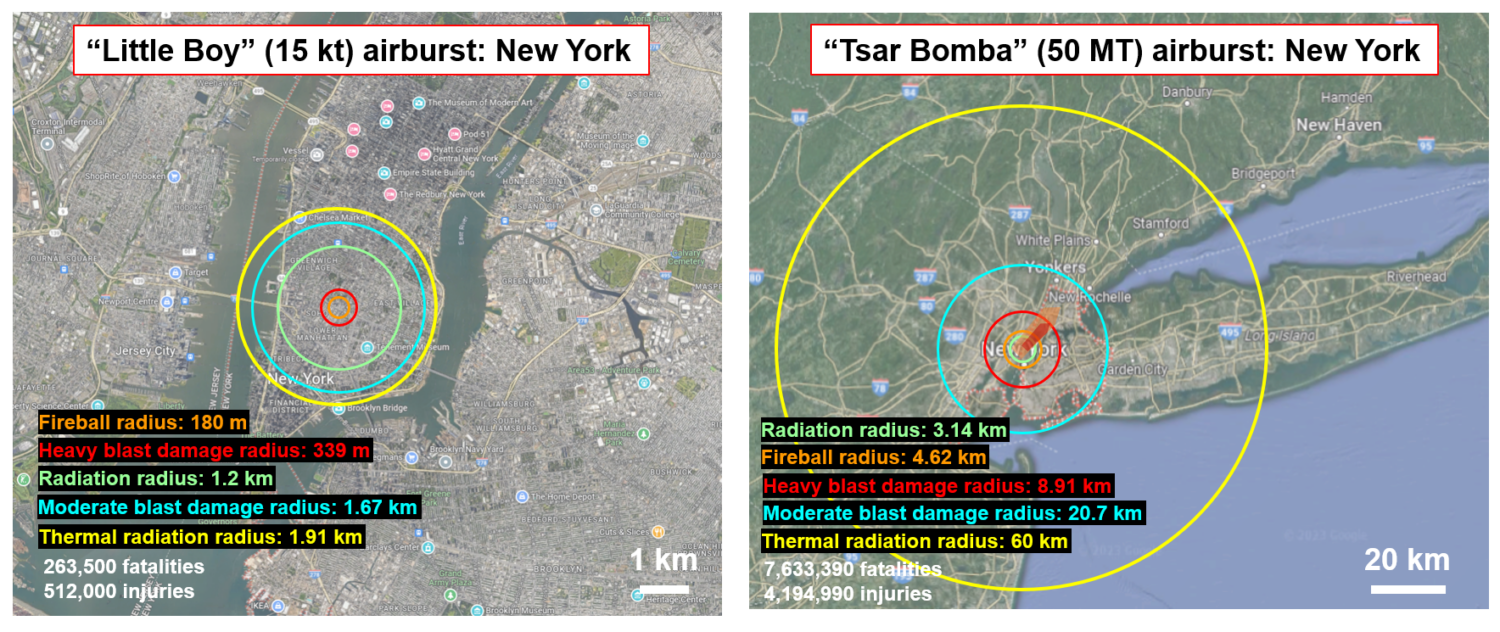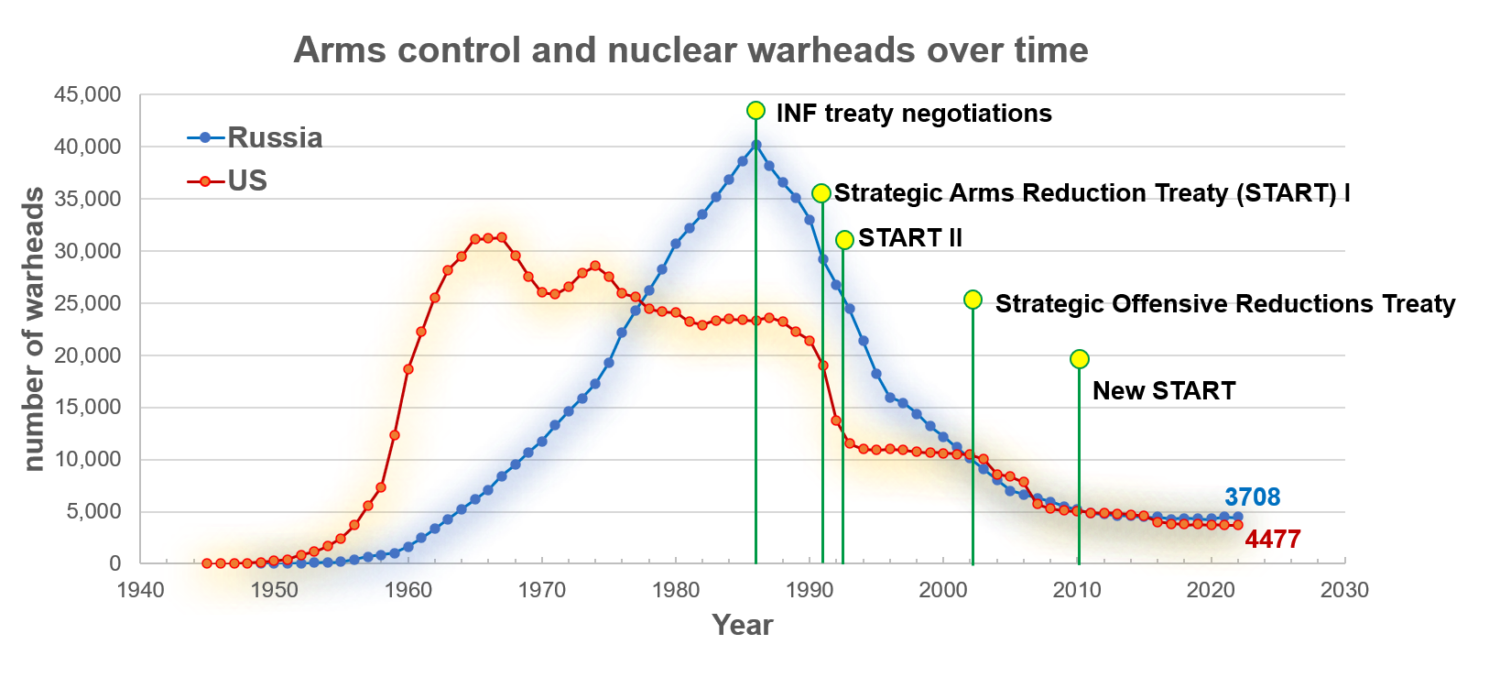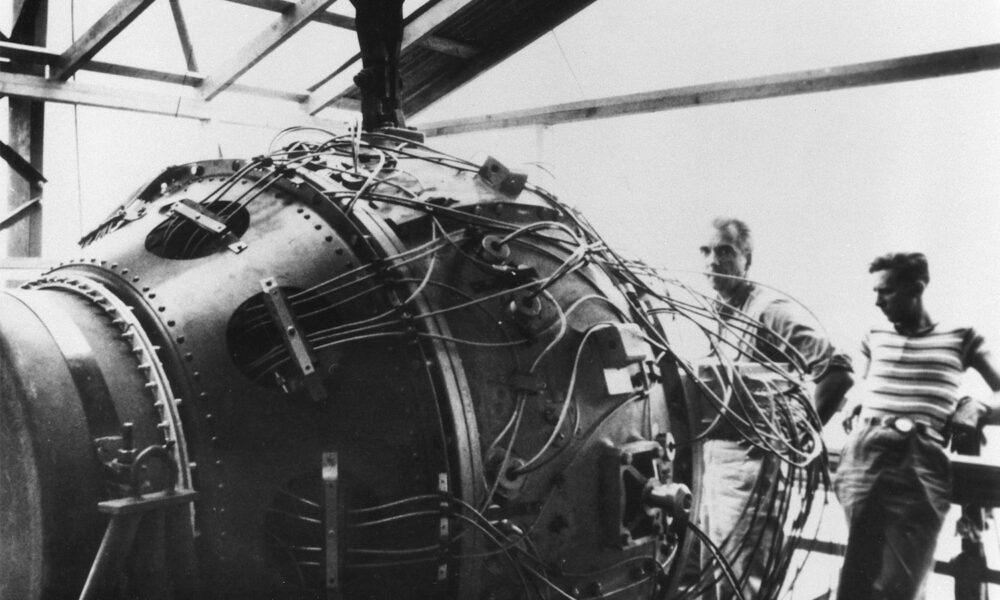Read more of UCS’s critical analysis of Oppenheimer and the global security issues it examines here.
It took the Manhattan project three years to develop a nuclear bomb: and only weeks between the first nuclear test explosion and the use of a nuclear weapon in war. Almost 80 years later – how have nuclear weapons evolved?
A brief history of nuclear testing
In 1945, the United States dropped two atomic bombs on Japan. The first bomb, codenamed “Little Boy” was dropped on Hiroshima on August 6, 1945.Three days later, the US dropped the second bomb, “Fat Man,” on Nagasaki. The two bombs, each with an estimated yield of around 15 and 21 kilotons (15,000 and 21,000 tons of TNT equivalent), respectively, caused widespread destruction, resulting in the loss of more than 100,000 lives.
After the war, the US conducted atmospheric nuclear tests in the Pacific Proving Grounds in the Marshall Islands and in Nevada and many more underground. The Soviet Union, Great Britain, France, China, India, Pakistan, and North Korea tested nuclear weapons of their own. Since the first development of nuclear weapons, the total number of nuclear tests exceeds 2,000, with 528 tests conducted above ground. These above ground tests had a destructive force of more than 400,000 kilotons TNT. The tests provided the information to increase the sophistication of nuclear weapons designs. But the nuclear tests, and particularly the atmospheric tests, were enormously destructive to the land and communities that were exposed to their explosive power and radiation.

Timeline of nuclear weapons tests
The largest bomb ever made
Today’s modern nuclear warheads have undergone significant advancements in terms of design, technology, and destructive power. Notably, modern warheads are almost exclusively thermonuclear bombs, or hydrogen (H) bombs, which use both fusion and fission reactions to generate higher release of energy – tens of kilotons to several megatons TNT equivalent, or tens of times more powerful than the early atomic bombs. These bombs essentially use an atomic bomb as a trigger for the powerful fusion explosion.
The largest nuclear weapon to ever been tested, Tsar Bomba, had an estimated yield of 50 megatons (although it had a capacity double that) – an explosive yield greater than that of the Little Boy by a factor of 3,500. Literally translated as “King of bombs,” this monster atomic bomb, designed by the Soviet Union, generated a fireball that reached a diameter of 4 km (2.5 miles), and a mushroom cloud that rose over 60 km (40 miles) into the atmosphere. The blast wave was felt over 1,000 km away (over 620 miles), and its shockwave was detected 4,000 km away from its source, or nearly 2,500 miles away. To illustrate the increased scale of destructive power, if the same bomb dropped on Hiroshima was detonated in a major US city like New York City, 264,000 lives will be lost, along with 512,000 injuries. Tsar Bomba, on the same city, would kill more than 7.6 million people while injuring additional 4.2 million (Figure 2).

Effects of a nuclear bomb in New York. Source: nukemap.
Notably, however, such weapons are too large to be considered ‘operational’. Tsar Bomba, for example, weighed 27 tons with a size of 8 meters length and 2 meters diameter – making it impractical to be deployed in a ballistic missile.
Smaller, lighter, faster
Nuclear states have not just pursued larger and more powerful weapons. They have pushed to make weapons that are lighter and more compact, so that they can be carried in multiples, and lower yield, so that they can plausibly be used on a battlefield.
60 years after the biggest nuclear test, nuclear weapons have become smaller and more compact – a process of miniaturization that allows integration into various delivery systems. Some modern weapons are also designed with multiple warheads, with enhanced precision for guidance and targeting systems, allowing a single delivery vehicle to carry multiple independent nuclear payloads.
Alongside high-yield strategic nuclear weapons, there has been significant development of non-strategic, or tactical nuclear weapons designed for limited use scenarios. These weapons are generally of lower yield and intended for use on the battlefield i.e., strikes against relatively close and specific targets that minimize collateral damage affecting the civilian population. But despite sometimes being referred to as “small nukes”, these weapons still cause devastating destruction. The explosive yield of tactical nuclear weapons today ranges from anywhere below one kt to above 100 kt: the high-end surpasses the yield of Little Boy and Fat Man by up to five times. Despite the lower yield and smaller size, the use of tactical nuclear weapons carries a high risk of escalation from potential misinterpretation, miscalculation, or an unintended response from adversaries, all of which can lead to a full-scale nuclear war. The availability of weapons, especially at low yields designed to facilitate battlefield use, increases the probability of their use in a conflict scenario.
In addition to the nuclear weapons themselves, the nuclear weapons state and non-weapons state have invested heavily in many delivery systems – strategic missile and conventional missile capabilities, as well as in missile defense systems. Nuclear strategists and scientists have long argued that the development and deployment of missile defense systems are ineffective against determined adversaries, but the US budget requested for $10.9 billion to strengthen and expand the deployment of missile defenses in 2023. Such development of missile defense systems has potential for encouraging an arms race dynamic and the Anti-Ballistic Missile Treaty’s role in trying to arrest that dynamic.
Almost 80 years after the first nuclear weapon was dropped on Japan, there hasn’t been any use of nuclear weapons on another country. But since then, nuclear states accumulated as many as 60,000 weapons in total at one time, and currently the nine states possessing nuclear weapons have approximately 13,000 nuclear weapons, with US and Russia accounting for almost 90% of the inventory These modern nuclear warheads are significantly more lethal compared to the atomic bombs used in Hiroshima and Nagasaki. The radius of devastation and the resulting blast effects, such as firestorms, radioactive fallout, and thermal radiation, would be significantly larger, amplifying the casualties and long-term environmental and health consequences. Despite the danger posed by nuclear weapons, the US continues programs to build new nuclear weapons, including a nuclear-armed sea-launched cruise missiles (SLCM-N).

Arms control and nuclear warheads over time for the US and Russia/USSR.
The use of nuclear weapons would have catastrophic humanitarian, environmental and geopolitical consequences. As we continue to invest and enhance nuclear weapons technologically, the global community continues to grapple with the challenges and risks associated with their existence. The pursuit of disarmament, nonproliferation, arms control, and diplomatic dialogues remains more crucial today than ever in promoting peace and global security.

